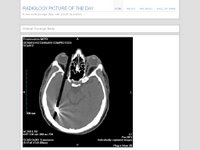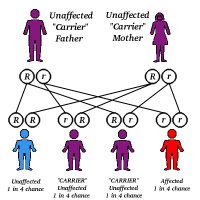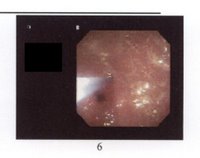
Orange dots on the map represent the readers of ClinicalCases.org and CasesBlog.
Map via Google Analytics. Idea from GigaOM.

 ClinicalCases.org and Casesblog have reached the milestone of one million page views since their launch in 2005 (see the SiteMeter screenshot on the right). We stand at 1,007,723 page views and 348,425 visits as of today. Most of the visitors came from Google, links from other medical websites and blogs, and from BMJ and Medscape. Just as a short explanation, ClinicalCases.org is an attempt to build an online case-based curriculum of medicine; Casesblog is the blog I use to collect ideas, interesting stories and to post relevant news about the Clinical Cases and Images project.
ClinicalCases.org and Casesblog have reached the milestone of one million page views since their launch in 2005 (see the SiteMeter screenshot on the right). We stand at 1,007,723 page views and 348,425 visits as of today. Most of the visitors came from Google, links from other medical websites and blogs, and from BMJ and Medscape. Just as a short explanation, ClinicalCases.org is an attempt to build an online case-based curriculum of medicine; Casesblog is the blog I use to collect ideas, interesting stories and to post relevant news about the Clinical Cases and Images project. I am not sure if these are really the "best" posts on this blog for 2006 but I sometimes find them useful for my "Web 2.0 in Medicine" presentations and decided to collect them in one place:
I am not sure if these are really the "best" posts on this blog for 2006 but I sometimes find them useful for my "Web 2.0 in Medicine" presentations and decided to collect them in one place: Casesblog and ClinicalCases.org have had automatic translation via Google Translate for a while now (see the form in the lower right corner of any page). I have noticed through SiteMeter statistics that some international visitors are using the form to translate the blog and ClinicalCases.org into their native language.
Casesblog and ClinicalCases.org have had automatic translation via Google Translate for a while now (see the form in the lower right corner of any page). I have noticed through SiteMeter statistics that some international visitors are using the form to translate the blog and ClinicalCases.org into their native language.One of the best blogs in medicine is Ves Dimov's Clinical Cases and Images - Blog. It contains a rich collection of "presurfed" material for busy clinicians and features interactivity and timely discussion. Dimov is also a supporter of medical librarian bloggers. Why waste time fumbling with search engines when you can consult this blog for timely updates? As well as case discussions, Ves provides links to today's medical headlines from Reuters and clinical images via a dynamic, free photo sharing tool called Flickr. One of his slide presentations "Web 2.0 in medicine" is available on Slideshare (itself a fantastic new 2.0 tool). Clinical Cases and Images is a virtual laboratory for doctors and medical librarians interested in Web 2.0.Since its launch in 2005, ClinicalCases.org and this blog were featured 3 times in the BMJ and twice in Medscape.
 From Wikipedia:
From Wikipedia: Dr. Charles links to a wonderful editorial response to the letter of a 8-year old girl who doubted that Santa Claus existed. It was published in the New York Sun in 1897. Not much has changed since then.
Dr. Charles links to a wonderful editorial response to the letter of a 8-year old girl who doubted that Santa Claus existed. It was published in the New York Sun in 1897. Not much has changed since then.Dear Editor--
I am 8 years old. Some of my little friends say there is no Santa Claus. Papa says, "If you see it in The Sun, it's so." Please tell me the truth, is there a Santa Claus?
~VIRGINIA O'HANLON
 Dave Walker, the author of free (and really funny) cartoons which I have used before, has released a 2007 Cartoon Calendar:
Dave Walker, the author of free (and really funny) cartoons which I have used before, has released a 2007 Cartoon Calendar: Radiology Picture of the Day features a new medical image daily, with a brief description. The website is edited and maintained by Dr. Laughlin Dawes who is a Radiology Registrar at Prince of Wales Hospital, Randwick. He lives in Sydney "with his wife Daniella, his sons Max and Alex, and Oscar the dog."
Radiology Picture of the Day features a new medical image daily, with a brief description. The website is edited and maintained by Dr. Laughlin Dawes who is a Radiology Registrar at Prince of Wales Hospital, Randwick. He lives in Sydney "with his wife Daniella, his sons Max and Alex, and Oscar the dog." The nominations for the Best Medical Blogs of 2006 are currently underway on Medgadget.com.
The nominations for the Best Medical Blogs of 2006 are currently underway on Medgadget.com.
 Background
BackgroundAdministrator:There is (was?) also a Wikipedia page about one of the medical bloggers, Summer Sethi, which was labeled for deletion as a "vanity page":
Welcome to Wikipedia. We invite everyone to contribute constructively to our encyclopedia. Take a look at the welcome page if you would like to learn more about contributing. However, unconstructive edits, such as your changes to the Raymond V. Damadian page, are considered vandalism, and if you continue in this manner you may be blocked from editing without further warning. Please stop, and consider improving rather than damaging the hard work of others. Thank you. Talk: Administrator.
Plastic surgeon:
Unconstructive edits, vandalism? nonsense. The page on Raymon V Damadian contains numerous factual errors and much evident confusion about the technology which I was just attempting to correct. I'm and MD PhD who was there when all this stuff was going on. Even published papers in the field and know many of the princopals. See my comments at. Talk:Raymond V. Damadian.
Strong delete: Wikipedia is not a resume or publication list. There are perhaps thousands of other medical researchers with similar publications, nothing shows why this person is any more notable than them. --Ragib 23:59, 2 September 2006 (UTC)The Full-body scan article is another example of a disagreement between contributors and administrators.
 Gordon Brown is the Chancellor of the Exchequer of the United Kingdom (the British cabinet minister responsible for all economic and financial matters) and is expected to succeed Tony Blair as Prime Minister.
Gordon Brown is the Chancellor of the Exchequer of the United Kingdom (the British cabinet minister responsible for all economic and financial matters) and is expected to succeed Tony Blair as Prime Minister. Torcetrapib, a new medication developed by Pfizer, is very effective in increasing HDL levels ("good" cholesterol). There is a huge marketing niche for such medications since currently we lack a very efective pharmacological therapy for low HDL, apart from Niacin. The first hint of trouble for torcetrapib was the preliminary report that the drug increases blood pressure. The latest results from a trial of about 15000 patients show significantly increased mortality in the group treated with torcetrapib (7500 patients). According to a Pfizer spokesman, 82 patients taking the combination of torcetrapib and Lipitor died, compared to 51 deaths in the arm of the study where patients were taking Lipitor alone.
Torcetrapib, a new medication developed by Pfizer, is very effective in increasing HDL levels ("good" cholesterol). There is a huge marketing niche for such medications since currently we lack a very efective pharmacological therapy for low HDL, apart from Niacin. The first hint of trouble for torcetrapib was the preliminary report that the drug increases blood pressure. The latest results from a trial of about 15000 patients show significantly increased mortality in the group treated with torcetrapib (7500 patients). According to a Pfizer spokesman, 82 patients taking the combination of torcetrapib and Lipitor died, compared to 51 deaths in the arm of the study where patients were taking Lipitor alone. Moderation in practice of medicine is just as important as it is in life. Too much of a good thing can sometimes kill you.
Moderation in practice of medicine is just as important as it is in life. Too much of a good thing can sometimes kill you. Grand Rounds was conceived as a weekly hosting event which features the best posts in the medical blogosphere. Several outgrowths of the "original" Grand Rounds have appeared recently, arranged mainly by subspecialty or location. I do not think that they will dilute the Grand Rounds "brand" and they may be interesting to follow. A list is compiled below:
Grand Rounds was conceived as a weekly hosting event which features the best posts in the medical blogosphere. Several outgrowths of the "original" Grand Rounds have appeared recently, arranged mainly by subspecialty or location. I do not think that they will dilute the Grand Rounds "brand" and they may be interesting to follow. A list is compiled below:






 According to a BMJ study, Google searches revealed the correct diagnosis in 58% of cases published in the case records of the New England Journal of Medicine in 2005. In each of the 26 cases studied, researchers selected 3-5 terms from each case and did a Google search without knowing the correct diagnoses.
According to a BMJ study, Google searches revealed the correct diagnosis in 58% of cases published in the case records of the New England Journal of Medicine in 2005. In each of the 26 cases studied, researchers selected 3-5 terms from each case and did a Google search without knowing the correct diagnoses. Noisely is supposedly an "intelligent podcast player". According to Download Squad, if you enter words that describe what you want to listen to, Noisely will find the right podcast for you. "Noisely works solely online in your browser and searches through their database, spitting out results based on matching keywords, and the date the actual podcast took place."
Noisely is supposedly an "intelligent podcast player". According to Download Squad, if you enter words that describe what you want to listen to, Noisely will find the right podcast for you. "Noisely works solely online in your browser and searches through their database, spitting out results based on matching keywords, and the date the actual podcast took place." November, December and January are the busiest months of the year for the U.S. medical students and international medical graduates looking to secure a position in internal medicine residency.
November, December and January are the busiest months of the year for the U.S. medical students and international medical graduates looking to secure a position in internal medicine residency.
 Richard Savel is the author of many firsts. In 2005, he made the first podcast for a national medical society -- the official podcast of the Society of Critical Care Medicine. Last month, Dr. Savel published the first paper about medical podcasting in the Journal of the American Medical Informatics Association:
Richard Savel is the author of many firsts. In 2005, he made the first podcast for a national medical society -- the official podcast of the Society of Critical Care Medicine. Last month, Dr. Savel published the first paper about medical podcasting in the Journal of the American Medical Informatics Association: Google brings blogs at the top of search results for many medical queries. This is good for bloggers but is it good for patients who search medical information online? Probably not, since many of them do not bother to check how reliable the source of the information is.
Google brings blogs at the top of search results for many medical queries. This is good for bloggers but is it good for patients who search medical information online? Probably not, since many of them do not bother to check how reliable the source of the information is. UBC Academic Search - Google Scholar Blog was the place to go for updates and insights on how medical librarians, physicians and patients are using search engines to sort out the staggering amount of information on the web. Now, Dean Giustini, the blog author is putting the site on hiatus for at least a year:
UBC Academic Search - Google Scholar Blog was the place to go for updates and insights on how medical librarians, physicians and patients are using search engines to sort out the staggering amount of information on the web. Now, Dean Giustini, the blog author is putting the site on hiatus for at least a year:UBC Google scholar blog is going on hiatus. Well, let's just call it a sabbatical. As of January 2007, a sign will go up saying Gone fishing - see you in 2008. I am going to be immersing myself in learning theory for my 2007 sabbatical, and that means I won't be tracking trends in search. What will happen to GS blog? What about the wiki? All good questions.
I am pondering what to do next. Will I return here? Time will tell.
 Several months ago, Cleveland Clinic launched a video podcast for patients called HealthEdge. The next logical step was to have a similar service for health professionals.
Several months ago, Cleveland Clinic launched a video podcast for patients called HealthEdge. The next logical step was to have a similar service for health professionals. So many feeds to read, so little time... Which are the good ones? There is a "proof-of-concept" website which helps you quickly browse the feeds which many people have already chosen.
So many feeds to read, so little time... Which are the good ones? There is a "proof-of-concept" website which helps you quickly browse the feeds which many people have already chosen. Diabetes mellitus (DM) and hypertension (HTN) increase the risk for development of chronic kidney disease (CKD). Type 2 diabetes (DM 2) is the biggest single cause of ESRD in the United States which is reflected in the mnemonic for differential diagnosis of CKD.
Diabetes mellitus (DM) and hypertension (HTN) increase the risk for development of chronic kidney disease (CKD). Type 2 diabetes (DM 2) is the biggest single cause of ESRD in the United States which is reflected in the mnemonic for differential diagnosis of CKD. "He had CP and SOB, was diagnosed w NSTEMI, had a PCI and is now in MICU."
"He had CP and SOB, was diagnosed w NSTEMI, had a PCI and is now in MICU."